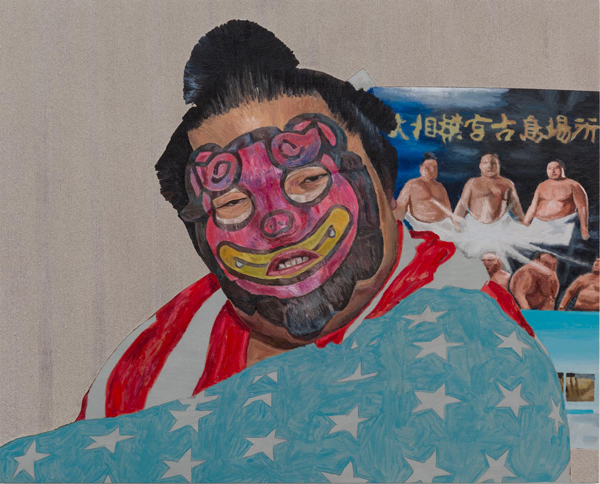Your cart is currently empty!
Hamishi Farah Chateau Shatto

Portraiture is almost certainly the artistic genre in which power and privilege imprint themselves most legibly. To “represent” can mean to depict, but also the right to speak on behalf of a group. The tension between these two meanings is at the heart of Hamishi Farah’s debut solo show at Chateau Shatto. Two distinct groups of portraits make up this conceptually ambitious exhibition: oil paintings of people who have, by one means or another, altered their face, and five self-portraits in charcoal, pastel and acrylic commissioned from Rachel Dolezal. Farah’s approach prioritizes the referential capabilities of portraiture over formal innovation. These paintings point to compelling issues, but their pictorial language is conventional.
Two of Farah’s paintings depict white men who have drawn on their faces with a black marker. A man with a scruffy beard sports an amateurish version of a batman mask across his forehead, nose and cheeks, while a more youthful guy stares blankly towards the viewer with what looks like half-assed blackface. Both images feel like mugshots, evoking the specter of criminal archetypes. So-called “black” markers actually contain deep purple ink, and these racially-tinged facial alterations come off as unambiguously pathetic. However, these jagged purple lines are the most visually exciting parts of the paintings. Rendered with energetic brushstrokes into wet paint, these passages stand out from the static, at times stiff quality of portraits painted from photographs. Farah’s other paintings depart from this racial binary: a bearded man with entirely purple skin, a sumo wrestler wearing a sheet mask, a woman with her head covered by a stocking, and a closeup of a bee. These portraits add complexity and humor to the theme of self-presentation while sticking to a relatively conservative painterly technique.

Rachel Dolezal, whose claims of Blackness have been widely rebuked and ridiculed, makes self-portraits that are as strange as you would expect them to be. She deploys clumsy metaphors to emphasize her own victimhood and uses a Jewish cookie to claim bi-racial identity. Black and White Cookie (2020) portrays Dolezal in a black headwrap holding the titular cookie in front of her, having just taken a bite—you guessed it—right down the middle. I spent the most time looking at Banished (2020), a charcoal drawing that reads as a surrealist allegory for depression. It shows a somber Dolezal standing next to a fence with a large hole missing from her abdomen. A black sun the size of her missing section looms ominously above. These amateurish works are ‘interesting’, in that they ask you to look more as a sociologist or psychologist. As with some of Farah’s own portraits, they illustrate how fixated humans can be on visual markers of identity, positing race as a particularly dangerous type of formalism.